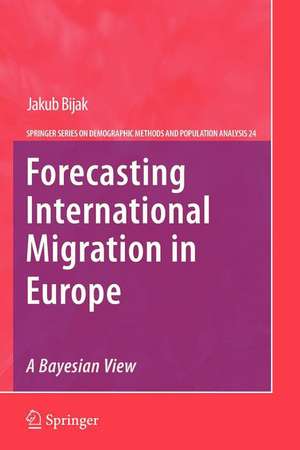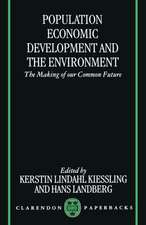Forecasting International Migration in Europe: A Bayesian View: The Springer Series on Demographic Methods and Population Analysis, cartea 24
Autor Jakub Bijak Contribuţii de Arkadiusz Wisniowskien Limba Engleză Paperback – dec 2012
| Toate formatele și edițiile | Preț | Express |
|---|---|---|
| Paperback (1) | 642.51 lei 6-8 săpt. | |
| SPRINGER NETHERLANDS – dec 2012 | 642.51 lei 6-8 săpt. | |
| Hardback (1) | 648.89 lei 6-8 săpt. | |
| SPRINGER NETHERLANDS – 31 oct 2010 | 648.89 lei 6-8 săpt. |
Din seria The Springer Series on Demographic Methods and Population Analysis
- 18%
 Preț: 951.14 lei
Preț: 951.14 lei - 15%
 Preț: 643.99 lei
Preț: 643.99 lei - 15%
 Preț: 643.16 lei
Preț: 643.16 lei - 18%
 Preț: 955.56 lei
Preț: 955.56 lei - 18%
 Preț: 952.40 lei
Preț: 952.40 lei -
 Preț: 393.90 lei
Preț: 393.90 lei -
 Preț: 393.74 lei
Preț: 393.74 lei - 15%
 Preț: 639.08 lei
Preț: 639.08 lei - 18%
 Preț: 952.89 lei
Preț: 952.89 lei - 18%
 Preț: 1118.45 lei
Preț: 1118.45 lei -
 Preț: 402.17 lei
Preț: 402.17 lei - 18%
 Preț: 953.82 lei
Preț: 953.82 lei - 15%
 Preț: 644.30 lei
Preț: 644.30 lei - 15%
 Preț: 663.93 lei
Preț: 663.93 lei - 18%
 Preț: 1380.95 lei
Preț: 1380.95 lei - 18%
 Preț: 953.65 lei
Preț: 953.65 lei - 18%
 Preț: 949.42 lei
Preț: 949.42 lei - 15%
 Preț: 644.82 lei
Preț: 644.82 lei - 18%
 Preț: 953.03 lei
Preț: 953.03 lei - 18%
 Preț: 952.09 lei
Preț: 952.09 lei - 15%
 Preț: 643.65 lei
Preț: 643.65 lei - 15%
 Preț: 643.99 lei
Preț: 643.99 lei - 15%
 Preț: 644.82 lei
Preț: 644.82 lei - 15%
 Preț: 644.95 lei
Preț: 644.95 lei - 15%
 Preț: 635.62 lei
Preț: 635.62 lei
Preț: 642.51 lei
Preț vechi: 755.88 lei
-15% Nou
Puncte Express: 964
Preț estimativ în valută:
122.95€ • 128.63$ • 102.13£
122.95€ • 128.63$ • 102.13£
Carte tipărită la comandă
Livrare economică 02-16 aprilie
Preluare comenzi: 021 569.72.76
Specificații
ISBN-13: 9789400733954
ISBN-10: 940073395X
Pagini: 340
Ilustrații: XXIV, 316 p.
Dimensiuni: 155 x 235 x 18 mm
Greutate: 0.48 kg
Ediția:2011
Editura: SPRINGER NETHERLANDS
Colecția Springer
Seria The Springer Series on Demographic Methods and Population Analysis
Locul publicării:Dordrecht, Netherlands
ISBN-10: 940073395X
Pagini: 340
Ilustrații: XXIV, 316 p.
Dimensiuni: 155 x 235 x 18 mm
Greutate: 0.48 kg
Ediția:2011
Editura: SPRINGER NETHERLANDS
Colecția Springer
Seria The Springer Series on Demographic Methods and Population Analysis
Locul publicării:Dordrecht, Netherlands
Public țintă
ResearchCuprins
List of tables and figures.- Part I. Introduction.- Part II. Explaining and forecasting migration.- Part III. Examples of Bayesian migration predictions.- Part IV. Perspectives of forecast makers and users.- Part V. Conclusion.- Acknowledgements.- References.- Subject Index .- Index of Names.- Annex A. Data sources and the preparatory work.- Annex B. WinBUGS code used in the presented Bayesian forecasts.- Annex C. Bayesian forecasts of selected migration flows in Europe.
Recenzii
From the reviews:
“Forecasters know (or at least should know) that their forecasts never come true and that the magnitude of error increases with the forecast's horizon. Jakub Bijak proposes an elegant solution to this problem, namely an application of Bayesian statistics to migration forecasting. Methodology he proposes allows for quantification of forecast uncertainty, giving the forecast's user an idea of how accurate the forecast is. As in the past a transition form single-regional to multi-regional forecasts constituted a milestone in demographic forecasting, the methodology proposed by Bijak and advocated earlier by other demographers will constitute a similar milestone in the future.” Dr Marek Kupiszewski, Director of the Central European Forum for Migration and Population Research in Warsaw
“The book is structured in five parts comprising twelve chapters. … The book is well-addressed to both policy- and theory-oriented readers, demographers and in particular statistical demographers, as well as to postgraduate students of demography and migration.” (Christina Diakaki, Zentralblatt MATH, Vol. 1209, 2011)
“Forecasters know (or at least should know) that their forecasts never come true and that the magnitude of error increases with the forecast's horizon. Jakub Bijak proposes an elegant solution to this problem, namely an application of Bayesian statistics to migration forecasting. Methodology he proposes allows for quantification of forecast uncertainty, giving the forecast's user an idea of how accurate the forecast is. As in the past a transition form single-regional to multi-regional forecasts constituted a milestone in demographic forecasting, the methodology proposed by Bijak and advocated earlier by other demographers will constitute a similar milestone in the future.” Dr Marek Kupiszewski, Director of the Central European Forum for Migration and Population Research in Warsaw
“The book is structured in five parts comprising twelve chapters. … The book is well-addressed to both policy- and theory-oriented readers, demographers and in particular statistical demographers, as well as to postgraduate students of demography and migration.” (Christina Diakaki, Zentralblatt MATH, Vol. 1209, 2011)
Textul de pe ultima copertă
International migration is becoming an increasingly important element of contemporary demographic dynamics and yet, due to its high volatility, it remains the most unpredictable element of population change. In Europe, population forecasting is especially difficult because good-quality data on migration are lacking. There is a clear need for reliable methods of predicting migration since population forecasts are indispensable for rational decision making in many areas, including labour markets, social security or spatial planning and organisation. In addressing these issues, this book adopts a Bayesian statistical perspective, which allows for a formal incorporation of expert judgement, while describing uncertainty in a coherent and explicit manner. No prior knowledge of Bayesian statistics is assumed. The outcomes are discussed from the point of view of forecast users (decision makers), with the aim to show the relevance and usefulness of the presented methods in practical applications. “This is a great book that represents a step-change in the forecasting of international migration. Jakub Bijak advocates for the use of Bayesian statistics - a natural way to combine subjective prior information with statistical data. The Bayesian framework provides also a natural way to further develop the migration forecasting process that is ultimately aimed at accounting for and reducing the different uncertainties, and that involves cognitive agents with different expertise - migration experts, population forecasters and forecast users - in order to accomplish that aim. The book is a must for everyone interested knowing how migration, especially international, will evolve and respond to changing conditions, events and policies.” <Prof. Frans Willekens, Director of the Netherlands Interdisciplinary Demographic Institute (NIDI), The Hague, and Professor of Population Studies, University of Groningen
Caracteristici
A lens to look through into the future of international migration in Europe A migration forecaster’s toolkit, applying expert knowledge to account for uncertainty An honest account of the limits of predictability of international migration Hints for population-related decision making under uncertainty














